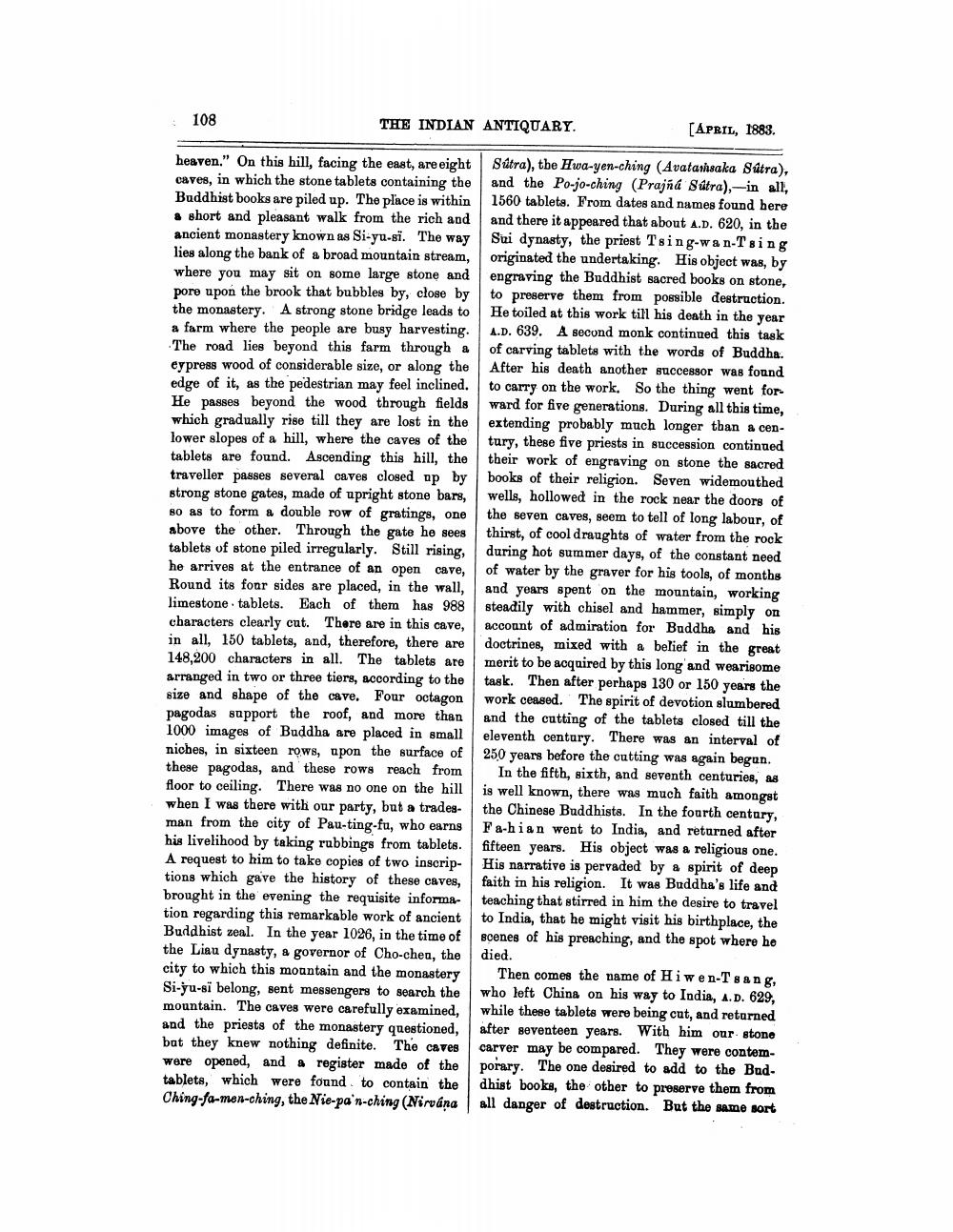________________
108
THE INDIAN ANTIQUARY.
[APRIL, 1883.
heaven." On this hill, facing the east, are eight Sutra), the Hwa-yen-ching (Avatamsaka Sútra), caves, in which the stone tablets containing the and the Po-jo-ching (Prajña Sútra),-in all, Buddhist books are piled up. The place is within 1560 tableta. From dates and names found here a short and pleasant walk from the rich and and there it appeared that about A.D. 620, in the ancient monastery known as Si-yu.si. The way Sui dynasty, the priest Tsing-wan-Tsing lies along the bank of a broad mountain stream, originated the undertaking. His object was, by where you may sit on some large stone and engraving the Buddhist sacred books on stone, pore upon the brook that bubbles by, close by to preserve them from possible destruction. the monastery. A strong stone bridge leads to He toiled at this work till his death in the year a farm where the people are busy harvesting. A.D. 639. A second monk continued this task The road lies beyond this farm through a of carving tablets with the words of Buddha. eypress wood of considerable size, or along the After his death another successor was found edge of it, as the pedestrian may feel inclined. to carry on the work. So the thing went for He passes beyond the wood through fields ward for five generations. During all this time, which gradually rise till they are lost in the extending probably much longer than a cenlower slopes of a hill, where the caves of the tury, these five priests in succession continued tablets are found. Ascending this hill, the their work of engraving on stone the sacred traveller passes several caves closed up by books of their religion. Seven widemouthed strong stone gates, made of upright stone bars, wells, hollowed in the rock near the doors of 80 as to form a double row of gratings, one the seven caves, seem to tell of long labour, of above the other. Through the gate he sees thirst, of cool draughts of water from the rock tablets of stone piled irregularly. Still rising, during hot summer days, of the constant need he arrives at the entrance of an open cave, of water by the graver for his tools, of months Round its four sides are placed, in the wall, and years spent on the mountain, working limestone tablets. Each of them has 988 steadily with chisel and hammer, simply on characters clearly cut. There are in this cave, account of admiration for Buddha and his in all, 150 tablets, and, therefore, there are doctrines, mixed with a belief in the great 148,200 characters in all. The tablets are merit to be acquired by this long and wearisome arranged in two or three tiers, according to the task. Then after perhaps 130 or 150 years the size and shape of the cave. Four octagon work ceased. The spirit of devotion slumbered pagodas support the roof, and more than and the cutting of the tablets closed till the 1000 images of Buddha are placed in small eleventh century. There was an interval of niches, in sixteen rows, upon the surface of 250 years before the cutting was again begun. these pagodas, and these rows reach from In the fifth, sixth, and seventh centuries, as floor to ceiling. There was no one on the hill is well known, there was much faith amongst when I was there with our party, but a trades- the Chinese Buddhists. In the fourth centary, man from the city of Pau-ting-fu, who earns Fa-hian went to India, and returned after his livelihood by taking rubbings from tablets. fifteen years. His object was a religious one. A request to him to take copies of two inscrip- His narrative is pervaded by a spirit of deep tions which gave the history of these caves, faith in his religion. It was Buddha's life and brought in the evening the requisite informa- teaching that stirred in him the desire to travel tion regarding this remarkable work of ancient to India, that he might visit his birthplace, the Buddhist zeal. In the year 1026, in the time of scenes of his preaching, and the spot where he the Liau dynasty, a governor of Cho-chea, the died. city to which this mountain and the monastery Then comes the name of Hiwen-Tsang, Si-yu-si belong, sent messengers to search the who left China on his way to India, A.D. 629, mountain. The caves were carefully examined, while these tablets were being cut, and returned and the priests of the monastery questioned, after seventeen years. With him our stone bat they knew nothing definite. The caves carver may be compared. They were contemwere opened, and a register made of the porary. The one desired to add to the Budtablets, which were found to contain the dhist books, the other to preserve them from Ching-fa-men-ching, the Nie-pa'n-ching (Nirvana all danger of destruction. But the same sort




